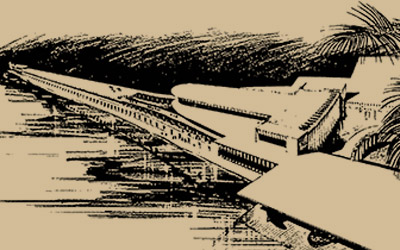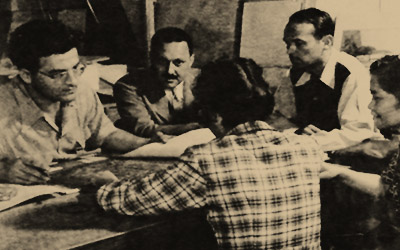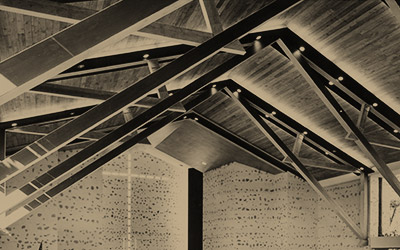Alfred Preis
A new life in Hawaii: First steps as an architect & Internment as an Enemy Alien (1939 – 1942)A Safe New World – the Paradise of the Pacific
The Preises arrived in New York on April 6, 1939 aboard the SS Queen Mary. The director of a Catholic charity and fellow Austrian helped them to arrange travel to California on the Sawoklah freight ship. It was the least expensive option. Stopping first in Norfolk, Virginia, Alfred proudly bought a Panama hat in celebration of travel to the tropics.
But after boarding a bus there, they had their first unfortunate taste of racial divisions in the Jim Crow-era South. “You can’t sit there,” the bus driver told them. “That’s for Negroes. You’ve got to sit over there,” he motioned. This display of racism disconcerted Preis, who had just fled ethnic persecution in Vienna. They were shocked to see it on full display in the so-called “land of the free.” After traveling through the Panama Canal, the couple reached San Pedro, California. They were welcomed by Lutah Maria Riggs who gave them daylong tour of Los Angeles and treated them to their first taste of a lime. After a final week at sea, they arrived at the island of O‘ahu on June 22, 1939 in the warm darkness of a typical Honolulu summer evening. Below the dark outlines of the staggering mountain peaks revealed in the moonlight, the city lights twinkled, and the rich scent of flowers filled the air.
The next morning, Bjarne Dahl met them at the ship, gave the couple a tour of their new city, and treated them to the Kodak hula show in Kapiolani Park. In the neighborhoods of Waikiki and the downtown, they would have seen a few examples of unornamented and modern-styled commercial and apartment buildings set here and there among the city’s many venerable historicist structures and its wooden bungalows with East Asian-styled details. Some of the most contemporary structures were designs by his new employer, Dahl & Conrad; a positive omen of things to come.
The turquoise waters, tropical light, languid humidity, sculptural banyan and palm trees, abundant flowers, and emerald green mountain ranges were a world apart from their busy, urban Vienna. Here, on this remote, Hawaiian archipelago with its verdant landscape and its diverse peoples, the young architect would embark on a quest to use his Vienna training and his nascent visions of modern architecture.
After Preis began work as a designer at the office of Dahl & Conrad, he and Janina moved to a studio apartment in Waikiki. They were excited to live near the famed Waikiki Beach among the palm trees and flowers in the small, but bustling and multiethnic city. At first, Preis felt overwhelmed and out of his depth with the breakneck speed of work at Dahl & Conrad. He had done some practical drafting with Redlich & Berger in Vienna, but he had never before been a lead designer on any project. Anxious about his lack of experience, he spent the first few months designing details. Conrad, an extremely talented designer and renderer, taught Preis new techniques for making perspectival drawings. Later, Preis considered Conrad to be his most important mentor recalling that he was the person who most truly helped him to “become an American architect.”
As his responsibilities at the firm increased, he began to develop his own architectural sensibilities. His clients ranged from the middle class to the wealthy and of many ethnicities. Encountering the arts and tastes of diverse peoples spurred in him a particular fascination for Asian form languages and color palettes. He was heavily influenced by the work of his mentors and popular American styles like the streamline moderne, but in his own designs he also brought a European modernist sensibility to the table.
A New Life in Honolulu Cut Short: Internment as an Enemy Alien
Things seemed to be going very well for the Preises. But on the morning of December 7, 1941, as the couple listened contentedly to a new record of Anton Bruckner’s Fifth Symphony, they heard and felt the impact of Japanese bombs at Pearl Harbor. Like most people in Honolulu, they mistakenly took the sounds for an unusually realistic military exercise. But they soon turned on the radio and heard the famous words, “this is not a maneuver. This is the real McCoy!” In just a few moments, the devastating attack stopped his life in paradise.
The very next evening, the Preises were approached by a civilian officer who informed them that they would be detained for questioning. Preis had already anticipated that their very recent arrival from Austria might cause a stir, but it never dawned on him that he would be arrested on the suspicion that he was collaborating with the Nazi power that was, at this very time, imprisoning and murdering his family. Fearful, they packed small, overnight bags and were transported to the U.S. Immigration Station in Honolulu. Alfred was deposited alone in a small, unlit room with other male prisoners from Europe and Japan.
The Preises were held there for several days, packed into close quarters and treated like criminals. Because the facility had not been designed as a prison, there were not enough beds or toilets for everyone. Alfred slept on the concrete floor of his communal cell and suffered from severe headaches. Some guards were sadistic: on one occasion he was forced at bayonet point to clean a communal toilet with his bare hands. When they were transferred to the Sand Island Detention Camp, the Preises were forced to strip naked for prison clothes and their wedding rings were confiscated. It was no doubt both terrifying and outrageous to be imprisoned and demeaned in the very country they sought refuge from racial prosecution at home.
In the camp, European prisoners were separated from Japanese, divided by twenty feet of barbed wire. Facilities were overcrowded and lacked enough sanitation. Without reading or writing materials, the internees passed the time with heavy exercise and conversation. They formed an intellectual discussion group, euphemistically named the “University of Sand Island,” trading lectures on art, music, and religion. Several of the German internees had been restaurant chefs and they tried to make the canned and spartan food distribution palatable.
To secure release, internees had to have an American citizen with social standing ‘vouch’ for their trustworthiness. Connie Conrad arranged for the established quarry owner, Chester Clarke, to vouch for the couple, signing an affidavit of their innocence. Preis had designed a house for Clarke just a few months before he was arrested. After almost four months in detention, Alfred and Janina were finally paroled together on March 28, 1942. Clarke also confirmed that he would offer Alfred a job. Like all internees, the Preises suffered the devastating loss of their apartment and virtually all their possessions. Bjarne Dahl came to their aid, inviting them to stay with him until the couple could afford a new apartment in Waikiki.
Because of the war and materials rationing, non-war-related architectural work had come to a complete halt; Dahl & Conrad were on the verge of dissolution. Preis spent the remainder of the war years doing blue-collar work for Clarke at his quarry in the Halawa Valley. He did basic inventory work and drove a bulldozer along with Clarke’s other men. He also earned a small commission designing five houses on the site for his fellow quarry workers. Ironically, this small group of proletarian houses boasted some of the most luxurious materials that Preis had ever been able to use in any residential commission. More expensive construction materials were less heavily rationed and therefore were actually cheaper and easier to obtain. But he would have to wait until the war’s end to resume his career in architecture.












